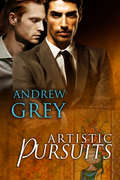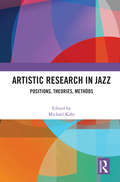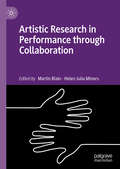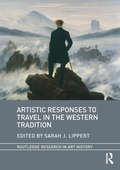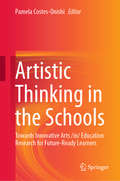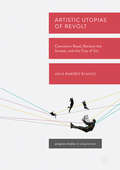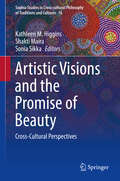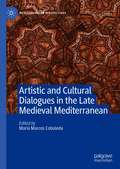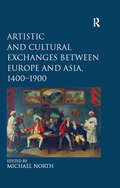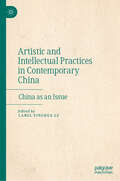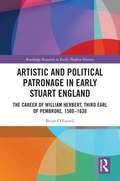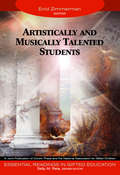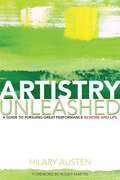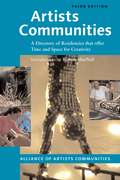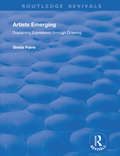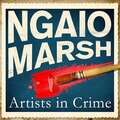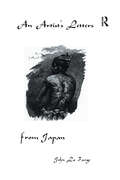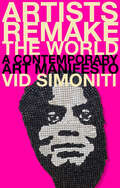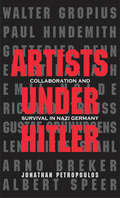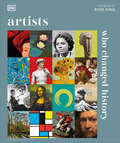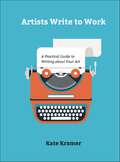- Table View
- List View
Artistic Pursuits (Art Series #3)
by Andrew GreyAn Art Series novelFrank Jennings is an FBI agent looking for redemption. Leslie Carlton is an Interpol agent looking for a thief. Attraction flares from the moment they meet on a case searching for a stolen triptych of unique Tiffany windows, but after a single night of stunning passion, Leslie is called back to London to continue his search there. When the case heats up again, Leslie returns to the States--and to Frank--but their investigation is complicated by their tumultuous feelings. Is it possible for two dedicated detectives to pursue each other while they're tracking down stolen art and the unscrupulous man who steals it?
Artistic Research in Jazz: Positions, Theories, Methods
by Michael KahrThis book presents the recent positions, theories, and methods of artistic research in jazz, inviting readers to critically engage in and establish a sustained discourse regarding theoretical, methodological, and analytic perspectives. A panel of eleven international contributors presents an in-depth discourse on shared and specific approaches to artistic research in jazz, aiming at an understanding of the specificity of current practices, both improvisational and composed. The topics addressed throughout consider the cultural, institutional, epistemological, philosophical, ethical, and practical aspects of the discipline, as well as the influence of race, gender, and politics. The book is structured in three parts: first, on topics related to improvisation, theory and history; second, on institutional and pedagogical positions; and third, on methodical approaches in four specific research projects conducted by the authors. In thinking outside established theoretical frameworks, this book invites further exploration and participation, and encourages practitioners, scholars, students, and teachers at all academic levels to shape the future of artistic research collectively. It will be of interest to students in jazz and popular music studies, performance studies, improvisation studies, music philosophy, music aesthetics, and Western art music research.
Artistic Research in Performance through Collaboration
by Helen Julia Minors Martin BlainThis volume explores the issue of collaboration: an issue at the centre of Performance Arts Research. It is explored here through the different practices in music, dance, drama, fine art, installation art, digital media or other performance arts. Collaborative processes are seen to develop as it occurs between academic researchers in the creative arts and professional practitioners in commercial organisations in the creative arts industries (and beyond), as well as focusing attention and understanding on the tacit/implicit dimensions of working across different media.
Artistic Responses to Travel in the Western Tradition (Routledge Research in Art History)
by Sarah J. LippertIn an era when ease of travel is greater than ever, it is also easy to overlook the degree to which voyages of the body – and mind – have generated an outpouring of artistry and creativity throughout the ages. Exploration of new lands and sensations is a fundamental human experience. This volume in turn provides a stimulating and adventurous exploration of the theme of travel from an art-historical perspective. Topical regions are covered ranging from the Grand Tour and colonialism to the travels of Hadrian in ancient times and Georgia O’Keeffe’s journey to the Andes; from Vasari’s Neoplatonic voyages to photographing nineteenth-century Japan. The scholars assembled consider both imaginary travel, as well as factual or embellished documentation of voyages. The essays are far-reaching spatially and temporally, but all relate to how art has documented the theme of travel in varying media across time and as illustrated and described by writers, artists, and illustrators. The scope of this volume is far-reaching both chronologically and conceptually, thereby appropriately documenting the universality of the theme to human experience.
Artistic Thinking in the Schools: Towards Innovative Arts /in/ Education Research for Future-Ready Learners
by Pamela Costes-OnishiThis book examines current context-specific trends and developments in empirical research on arts education and arts in education, in order to evaluate and create responsive approaches to future global challenges. By highlighting the centrality of the arts in advancing future orientations in education, it offers a timely and valuable contribution to educational issues on preparing teachers and learners for the increasingly complex societal dynamics and unpredictable global economy.
Artistic Utopias of Revolt: Claremont Road, Reclaim the Streets, and the City of Sol (Palgrave Studies in Utopianism)
by Julia Ramírez BlancoThis book analyses the aesthetic and utopian dimensions of various activist social movements in Western Europe since 1989. Through a series of case studies, it demonstrates how dreams of a better society have manifested themselves in contexts of political confrontation, and how artistic forms have provided a language to express the collective desire for social change.<p><p> The study begins with the 1993 occupation of Claremont Road in east London, an attempt to prevent the demolition of homes to make room for a new motorway. In a squatted row of houses, all available space was transformed and filled with elements that were both aesthetic and defensive – so when the authorities arrived to evict the protestors, sculptures were turned into barricades. At the end of the decade, this kind of performative celebration merged with the practices of the antiglobalisation movement, where activists staged spectacular parallel events alongside the global elite’s international meetings. As this book shows, social movements try to erase the distance that separates reality and political desire, turning ordinary people into creators of utopias. Squatted houses, carnivalesque street parties, counter-summits, and camps in central squares, all create a physical place of these utopian visions
Artistic Visions and the Promise of Beauty: Cross-Cultural Perspectives (Sophia Studies in Cross-cultural Philosophy of Traditions and Cultures #16)
by Sonia Sikka Kathleen M. Higgins Shakti MairaThis volume examines the motives behind rejections of beauty often found within contemporary art practice, where much critically acclaimed art is deliberately ugly and alienating. It reflects on the nature and value of beauty, asking whether beauty still has a future in art and what role it can play in our lives generally. The volume discusses the possible "end of art," what art is, and the relation between art and beauty beyond their historically Western horizons to include perspectives from Asia. The individual chapters address a number of interrelated issues, including: art, beauty and the sacred; beauty as a source of joy and consolation; beauty as a bridge between the natural and the human; beauty and the human form; the role of curatorial practice in defining art; order and creativity; and the distinction between art and craft. The volume offers a valuable addition to cross-cultural dialogue and, in particular, to the sparse literature on art and beauty in comparative context. It demonstrates the relevance of the rich tradition of Asian aesthetics and the vibrant practices of contemporary art in Asia to Western discussions about the future of art and the role of beauty.
Artistic Visions of the Anthropocene North: Climate Change and Nature in Art (Routledge Advances in Art and Visual Studies)
by Gry Hedin Ann-Sofie N. GremaudIn the era of the Anthropocene, artists and scientists are facing a new paradigm in their attempts to represent nature. Seven chapters, which focus on art from 1780 to the present that engages with Nordic landscapes, argue that a number of artists in this period work in the intersection between art, science, and media technologies to examine the human impact on these landscapes and question the blurred boundaries between nature and the human. Canadian artists such as Lawren Harris and Geronimo Inutiq are considered alongside artists from Scandinavia and Iceland such as J.C. Dahl, Eija-Liisa Ahtila, Toril Johannessen, and Björk.
Artistic and Cultural Dialogues in the Late Medieval Mediterranean (Mediterranean Perspectives)
by María Marcos CobaledaThis book analyses the artistic and cultural legacy of Western Islamic societies and their interactions with Islamic, Christian and Jewish societies in the framework of the late medieval Mediterranean, from a range of multi-disciplinary perspectives. The book, organised in four parts, addresses the Andalusi legacy from its presence in the East and the West; analyses the relations and transfers between Al-Andalus and the artistic productions of the Christian kingdoms of the Iberian Peninsula; explores other manifestations of the Andalusi legacy in the fields of knowledge, construction, identity and religious studies; and reconsiders ornamental transfers and exchanges in artistic manifestations between East and West across the Mediterranean basin.Chapter 2 is open access under a CC BY 4.0 license.
Artistic and Cultural Exchanges between Europe and Asia, 1400-1900: Rethinking Markets, Workshops and Collections
by Michael NorthThe European expansion to Asia was driven by the desire for spices and Asian luxury products. Its results, however, exceeded the mere exchange of commodities and precious metals. The meeting of Asia and Europe signaled not only the beginnings of a global market but also a change in taste and lifestyle that influences our lives even today. Manifold kinds of cultural transfers evolved within a market framework that was not just confined to intercontinental and intra-Asiatic trade. In Europe and Asia markets for specific cultural products emerged and the transfers of objects affected domestic arts and craft production. Traditionally, relations between Europe and Asia have been studied in a hegemonic perspective, with Europe as the dominant political and economic centre. Even with respect to cultural exchange, the model of diffusion regarded Europe as the centre, and Asia the recipient, whereby Asian objects in Europe became exotica in the Kunst- und Wunderkammern. Conceptions of Europe and Asia as two monolithic regions emerged in this context. However, with the current process of globalization these constructions and the underlying models of cultural exchange have come under scrutiny. For this reason, the book focuses on cultural exchange between different European and Asian civilizations, whereby the reciprocal complexities of cultural transfers are at the centre of observation. By investigating art markets, workshops and collections in Europe and Asia the contributors exemplify the varieties of cultural exchange. The book examines the changing roles of Asian objects in European material culture and collections and puts a special emphasis on the reception of European visual arts in colonial settlements in Asia as well as in different Asian societies.
Artistic and Intellectual Practices in Contemporary China: China as an Issue
by Carol Yinghua LuThis edited volume is the first internationally available English translation of key lectures and essays delivered at Beijing’s Inside Out Art Museum over the past decade. The book elevates a chorus of voices from domestic and international intellectuals, artists, curators, and historians in a dialogue that reframes Chinese art from 1949 to the present.Part I offers critical academic complications of the story of Chinese art from the 1950s to the present as one singularly defined and stifled by political revolution. It traces important continuities and early examples of contemporary art practice to the Party’s birth and consolidation of power from the 1920s onwards. It relates the formation of contemporary art to the historical course of intellectual practice in China from 1949. Part II proposes China as an “issue” requiring historical interrogation rather than an inviolable entity. It questions the efficacy of “Asia” as a term, presents case studies of independentpublishers that challenged tightly crafted historical narratives, and wraps up with incisive reflections on the challenges confronting creatives and historians in China today.With chapters ranging from peer-reviewed scholarship to cuttingly humorous personal anecdotes, its contributing authors give rare, first-hand accounts of navigating pertinent historical and current situations, including censorship, China’s il/liberalism, and COVID-19. This book offers readers an ear to heretofore closed-door conversations in leading modern and contemporary art spaces.
Artistic and Political Patronage in Early Stuart England: The Career of William Herbert, Third Earl of Pembroke, 1580-1630
by Brian O'FarrellArtistic and Political Patronage in Early Stuart England explores the remarkable life and career of William Herbert, Third Earl of Pembroke. Pembroke was one of the most influential aristocrats during the reigns of Elizabeth I, James I and Charles I. He was a great patron, a prominent politician and electoral manager, an entrepreneur, and a gifted poet. Yet despite his influence and many talents, Pembroke’s life has been little studied by historians. Drawing on archival material, this book throws new light on Pembroke, and demonstrates just how significant he was during his lifetime. This book will appeal to scholars and students of early modern British history, as well as those interested in politics and patronage during the sixteenth and seventeenth centuries.
Artistically and Musically Talented Students
by Sally M. Reis Dr Enid ZimmermanMajor themes include nature versus nurture in arts talent development, teacher empowerment, and collaboration with community members.
Artistry Unleashed
by Hilary Austen University of TorontoArtistry Unleashed is about working and living at the edge of what you know and beyond. Surprise, uncertainty, ambiguity, intensity, and change are all disruptive forces that we often avoid or fear. Yet they are the essential origin of both creativity and great performance.Imagine if you could make effective progress with no clear plan or destination in view; if you could achieve excellence without sacrificing creativity; if you could invest passion even as you apply reason and intelligence. Learn how artistry, when allowed to escape studio walls, can help painters, CEOs, athletes, scientists, chefs, and you to achieve these powerful capabilities. Artistry Unleashed provides original and practical tools to transform what we think about artistry's role in professions, in organizations, in education, and, most importantly, in everyday life. Artistry Unleashed reveals the unique features of artistic work in any field: enigmatic problems; qualitative intelligence; cognitive emotions; downstream and upstream learning; and your personal knowledge system.
Artists At Work
by Bernard ChaetChaet explores the relationship between an artist's materials and technique, and the forms in which he expresses his vision. He shows that technique and vision are inseparable.
Artists Communities: A Directory of Residencies that Offer time and Space for Creativity (Artists Communities: A Directory Of Residences That Offer Time And Spa Ser.)
by Robert Macneil The Alliance of Artists' CommunitiesThe bible of creative residency programs returns, with fresh information and new features for artists of all disciplines. More than 300 programs worldwide are described, with 95 leading communities featured in two-page spreads with photographs. The user-friendly layout allows for quick scans of facility descriptions, deadlines, fees, selection processes, odds of acceptance, special programs, and more. For artists seeking to boost their creativity in a fresh and inspiring setting, Artists' Communities is the definitive sourcebook.
Artists Emerging: Sustaining Expression through Drawing (Routledge Revivals)
by Tom Phillips Sheila PaineThis title was first published in 2000. Most children enjoy drawing and use it to express a wide range of experiences and emotions. Drawing can offer an avenue of expression where words fail. So why do many people stop drawing after the early school years? This is an examination of the early work of John Everett Millais, Henri de Toulouse-Lautrec, Pablo Picasso, Michael Rothenstein, Gerard Hoffnung, Sarah Raphael and David Downes to investigate the reasons why these artists were able to sustain and develop their drawing skill and expressive potential while others failed. The close study of these artists' early drawings reveals their sequences of progress and their eventual achievement. Sheila Paine, a former President of the National Society for Education in Art and Design, shares the experience of a lifetime's work in art education to explore the mysteries of drawing fluency, its often precocious beginnings, and the personal, social and cultural circumstances which help or hinder its development.
Artists In Crime (Inspector Alleyn #34)
by Ngaio MarshWhen murder upsets the creative tranquility of an artists' colony, Scotland Yard sends in its most famous investigator. And what begins as a routine case turns out to be the most momentous of Roderick Alleyn's career. For before he can corner the killer, his heart is captured by one of the suspects - the flashing-eyed painter Agatha Troy, who has nothing but scorn for the art of detection....Artists in Crime was first published in 1938.
Artists Labour Market, Cultural Policy and Creative Economy: A Triangular Model in Poland (Routledge Focus on Economics and Finance)
by Dorota Ilczuk Anna Karpińska Emilia CholewickaFocusing on artists and creators, this shortform book analyses the labour market in the creative economy in the context of cultural policies.Based on a series of studies involving Polish artists spanning 10 years, the book identifies the key factors needed to understand contemporary labour markets in the creative and cultural sectors worldwide. The authors integrate artists’ perspectives to present truly rounded evidence, shedding light on the applicational perspective of the research findings.Illuminating the socioeconomic status of artists in Poland, this book is essential reading for researchers interested in cultural policy and the creative economy, as well as work and labour studies more broadly. It will also be of interest to practitioners in the creative and cultural industries.
Artists Letters From Japan
by ForageFirst Published in 2001. Routledge is an imprint of Taylor & Francis, an informa company.
Artists Remake the World: A Contemporary Art Manifesto
by Vid SimonitiAn original and provocative exploration of the relationship between contemporary art, politics, and activism Artists Remake the World introduces readers to the political ambitions of contemporary art in the early twenty-first century and puts forward a new, wide-ranging account of art&’s political potential. Surveying such innovations as evidence-driven art, socially engaged art, and ecological art, the book explores how artists have attempted to offer bold solutions to the world&’s problems. Vid Simoniti offers original perspectives on contemporary art and its capacity as a force for political and social change. At its best, he argues, contemporary art allows us to imagine utopias and presents us with hard truths, which mainstream political discourse cannot yet articulate. Covering subjects such as climate change, social justice, and global inequality, Simoniti introduces the reader to a host of visionary contemporary artists from across the globe, including Ai Weiwei, Olafur Eliasson, Wangechi Mutu, Naomi Rincón Gallardo, and Hito Steyerl. Offering a philosophy of contemporary art as an experimental branch of politics, the book equips the reader with a new critical apparatus for thinking about political art today.
Artists Under Hitler
by Jonathan Petropoulos#147;What are we to make of those cultural figures, many with significant international reputations, who tried to find accommodation with the Nazi regime?” Jonathan Petropoulos asks in this exploration of some of the most acute moral questions of the Third Reich. In his nuanced analysis of prominent German artists, architects, composers, film directors, painters, and writers who rejected exile, choosing instead to stay during Germany’s darkest period, Petropoulos shows how individuals variously dealt with the regime’s public opposition to modern art. His findings explode the myth that all modern artists were anti-Nazi and all Nazis anti-modernist. Artists Under Hitler closely examines cases of artists who failed in their attempts to find accommodation with the Nazi regime (Walter Gropius, Paul Hindemith, Gottfried Benn, Ernst Barlach, Emil Nolde) as well as others whose desire for official acceptance was realized (Richard Strauss, Gustaf Gründgens, Leni Riefenstahl, Arno Breker, Albert Speer). Collectively these ten figures illuminate the complex cultural history of Nazi Germany, while individually they provide haunting portraits of people facing excruciating choices and grave moral questions.
Artists Unframed
by Merry ForrestaTucked away among the letters, diaries, and other ephemera in the Smithsonian's archives lies a trove of rarely seen snapshots of some of the twentieth century's most celebrated artists. Unlike the familiar official portraits and genius-at-work shots, these humble snaps capture creative giants with their guard down, in the moment, living life. Pablo Picasso stands proudly on a balcony with young daughter Maya--a tiny, meticulously inked annotation penned by an unknown hand proclaims that "he's very much in love." Jackson Pollock morosely carves a turkey while his mother, Stella, and wife, Lee Krasner, look on. A young Andy Warhol clowns for the camera with college friend Philip Pearlstein, and in a later shot more closely resembles his famously enigmatic public self at a gallery opening with John Lennon and Yoko Ono.
Artists Who Changed History (DK History Changers)
by DKThis visual celebration of the world's most celebrated thinkers tells the fascinating stories of their lives and pioneering ideas.Artists Who Changed History places well-known artists in their historical and cultural context, showing you how they came to influence Art as we know it today. This illustrated guide is ideal for those interested in art, sculptures, and the history of art or who would like to broaden their general understanding of art and the lives of artists.Inside this book on artists, you’ll find:-An overview of the lives and works of around 80 of the world's most influential artists - Middle Ages to the present day-Eight pages of brand-new content with 12 new entries, including Judith Leyster and Frank Bowling-Lavishly illustrated portraits of each artist alongside photographs of their homes and studios, original sketches, notebooks, lettersIn this Art guide, each artist is introduced with a realistic portrait and biographical entries that trace the friendships, loves, and rivalries that inspired and influenced them. Entries explore each individual's key ideas and working methods and set their ideas in context, conveying a powerful sense of the place and the period of history in which they lived. Artists Who Changed History provides revealing insights into what drove each individual to develop new ways of understanding the world.
Artists Write to Work: A Practical Guide to Writing about Your Art
by Kate KramerWriting and research strategies for documents every artist must craft: letters, applications, wall text, etc.Welcoming and effective, spells out clear connections between the writing process and creative practiceDestined to become an important addition to the libraries of art students, educators, and artists
